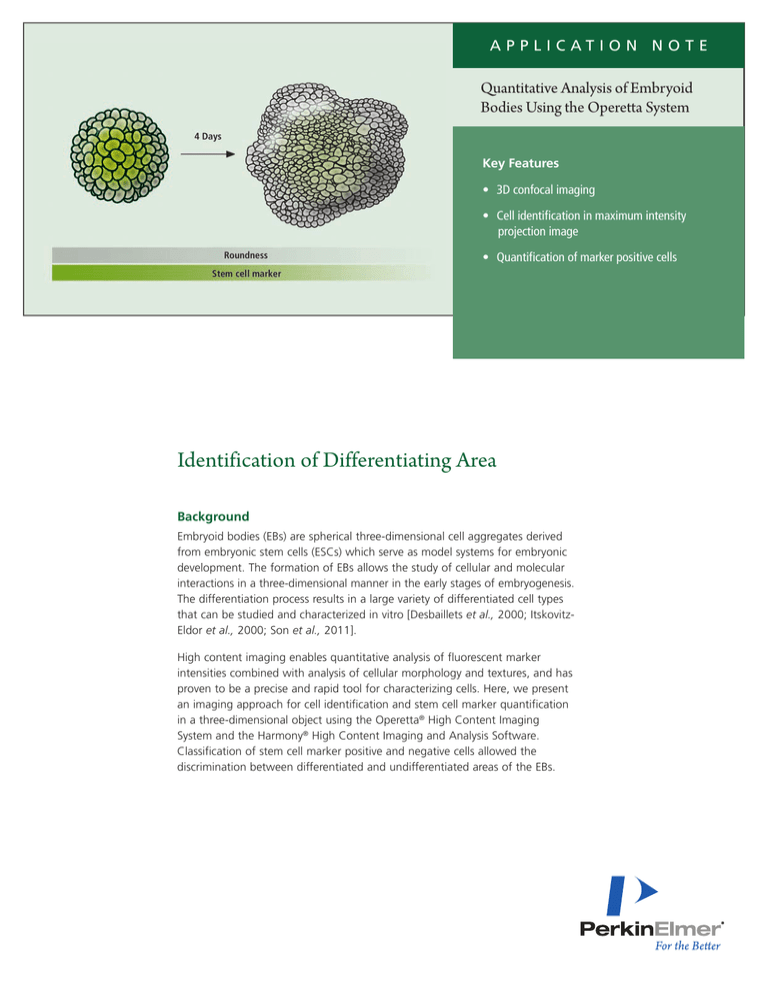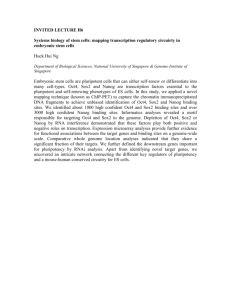
application Note
Quantitative Analysis of Embryoid
Bodies Using the Operetta System
Key Features
• 3D confocal imaging
• Cell identification in maximum intensity
projection image
• Quantification of marker positive cells
Identification of Differentiating Area
Background
Embryoid bodies (EBs) are spherical three-dimensional cell aggregates derived
from embryonic stem cells (ESCs) which serve as model systems for embryonic
development. The formation of EBs allows the study of cellular and molecular
interactions in a three-dimensional manner in the early stages of embryogenesis.
The differentiation process results in a large variety of differentiated cell types
that can be studied and characterized in vitro [Desbaillets et al., 2000; ItskovitzEldor et al., 2000; Son et al., 2011].
High content imaging enables quantitative analysis of fluorescent marker
intensities combined with analysis of cellular morphology and textures, and has
proven to be a precise and rapid tool for characterizing cells. Here, we present
an imaging approach for cell identification and stem cell marker quantification
in a three-dimensional object using the Operetta® High Content Imaging
System and the Harmony® High Content Imaging and Analysis Software.
Classification of stem cell marker positive and negative cells allowed the
discrimination between differentiated and undifferentiated areas of the EBs.
Application
ESCs were used that express GFP under the control of the Oct4
promoter, which directs transcription of a well known stem cell
marker [Rodriguez et al., 2007]. To study the differentiation
process, ESCs were differentiated into EBs using the hanging
drop method. ESCs were counted and adjusted to 3x104 cells/
mL in ESC medium without the cytokine LIF, and 20 µL drops
were spotted on the lid of a bacterial dish. The lid was inverted
and put back on the dish, which was filled with PBS to prevent
desiccation. After 4 days of incubation in hanging drops, EBs
were collected and propagated in ESC medium without LIF. EBs
were collected at day 4 and day 8, washed with PBS and fixed
with 3.7% formaldehyde for 30 min. Fixed 4-day and 8-day old
EBs were permeabilized with 0.5% Triton® X-100 (15 min). The
nuclei and actin cytoskeleton were stained by incubation with
Hoechst 33342 (20 µM) and Rhodamine Phalloidin (Invitrogen®,
final conc. 1 unit/mL), respectively. Finally the EBs were
transferred to a 384-well CellCarrier™ microtiter plate
(PerkinElmer, 6007550) for imaging.
Images were acquired on the Operetta system using the confocal
mode and a 20 X high NA objective. A z-stack of 80 planes
with a total distance of 160 µm was measured. For image
analysis, the stack rendering method “maximum intensity
projection” was used. With this method all planes of the stack
are reduced into a single projection image. This image is
4-day old EB
50 µm
created by selecting pixels with the highest signal intensity at
each position across the z-stacks and combining them into a
single image. The maximum projection images (Figure 1) were
used to calculate the morphology and intensity properties of
the 4-day and 8-day old EBs.
For image analysis, the EB region could be clearly discriminated
from the background by texture-based segmentation using the
actin image. By calculating the morphology properties of the
4-day old and 8-day old EB regions, there was a significant
difference in the readout comparing area and roundness of the
bodies. While the total area of the 8-day old EB clearly
increased, the roundness decreased due to an uneven and
complex structured surface of the EB (Figure 3). The Hoechst
channel enabled further segmentation of the EB into single
nuclei. By calculating the Oct4 intensity properties of each
nucleus, cells were subdivided into Oct4 intensity classes,
allowing the generation of a histogram (Figure 3). The
histogram clearly shows that the largest proportion of cells
from the 4-day old EB show a high Oct4 intensity, while the
8-day old EB contains mainly cells with lower Oct4 intensities.
This provides further evidence of the advanced differentiation
of the growing EB. Setting an Oct4 intensity threshold allowed
the separation of the cells into marker positive and marker
negative cell populations, enabling the identification of differentiated and undifferentiated regions inside the EB (Figure 2).
8-day old EB
Figure 1. Maximum intensity projection images of a 4-day old EB (left) and 8-day old EB (right). The maximum intensity projection was generated using all 80
planes of the acquired z-stack. Images show a false color overlay of nuclei (blue), actin (red) and Oct4 (green). Compared to the 4-day old EB, the 8-day old EB
is larger, more complex and expresses less stem cell marker Oct4, indicating advanced differentiation.
2
4-dayoldEB
8-dayoldEB
Figure 2. Image-based segmentation and identification of Oct4 positive/
negative areas in the maximum intensity projection image. Texture-based
segmentation enabled the EB region (upper panels, green border) to be found.
A nuclear mask was generated in the EB region and was used to calculate the
intensity properties of each nucleus in the Oct4-channel (middle panels).
Setting an intensity threshold allowed the selection of a marker positive and a
marker negative cell population (lower panels), and an undifferentiated area
(shown in green) and a differentiating area (shown in red) could be located.
EB 4 days
EB 8 days
Area [µm2]
146045
173542
Roundness
0.970446
0.852404
Oct4 mean intensity
2982.28
2359.58
Oct4 pos area [%]
97
35
Figure 3. Quantification of several readouts indicating differentiation of the
EBs. The Oct4 mean intensities of all detected nuclei were subdivided into
intensity classes. The histogram (upper panel) shows the number of nuclei in
each of the intensity classes for both EBs. The 4-day old EB (red bars) mainly
comprises cells with high Oct4 intensity whereas the 8-day old EB (blue bars)
contains mainly cells with low Oct4 intensity. The table (lower panel)
summarizes a selection of the most important quantitative readouts for
evaluating the progress of EB differentiation. As the increased area of the
8-day old EB indicates growth, the decreased values for roundness and the
Oct4 positive area both imply differentiation of the EB.
Conclusion
References
In this study, we analyzed three-dimensional embryoid bodies
(EBs) using the Operetta High Content Imaging System. The
applied method of confocal stack measurement combined with
analysis of the maximum intensity projection image is a robust
approach for characterizing 3D bodies. The maximum intensity
projection comprises extracted information from all planes
rather than each plane individually so that image analysis can
be achieved much more quickly.
1. Desbaillets I., Ziegler U., Groscurth P., Gassmann M.
(2000): Embryoid bodies: an in vitro model of mouse
embryogenesis. Exp Physiol., 85(6), 645-651.
Alongside the quantification of area, roundness and Oct4
intensity, the Harmony High Content Imaging and Analysis
Software enables the discrimination between differentiated and
undifferentiated regions of the EB by classifying cells according
to their Oct4 expression level. For the EBs studied here, we
observed a differentiation in the rim and outer regions while
the center remained undifferentiated after 8 days of
incubation. Further characterization of the differentiation
process through the inclusion of additional differentiation
markers into the high content imaging approach would be
straightforward.
2. Itskovitz-Eldor J., Schuldiner M., Karsenti D., Eden A.,
Yanuka O., Amit M., Soreq H., Benvenisty N. (2000):
Differentiation of human embryonic stem cells into
embryoid bodies compromising the three embryonic
germ layers. Mol Med., 6(2), 88-95.
3. Rodriguez R.T., Velkey J.M., Lutzko C., Seerke R., Kohn
D.B., O’Shea K.S., Firpo M.T. (2007): Manipulation of
OCT4 Levels in Human Embryonic Stem Cells Results in
Induction of Differential Cell Types. Exp Biol Med.,
232(10), 1368-1380.
4. Son M., Kim H., Kim M., Cho Y.S. (2011): Physical
Passaging of Embryoid Bodies Generated from Human
Pluripotent Stem Cells. PLoS One, 6(5), e19134.
3
Authors
Stefan Letzsch and Karin Böttcher
PerkinElmer
Cellular Technologies Germany GmbH
Cellular Imaging & Analysis
Hamburg, DE
Daniela Meilinger
LMU Biocenter
Munich, DE
PerkinElmer, Inc.
940 Winter Street
Waltham, MA 02451 USA
P: (800) 762-4000 or
(+1) 203-925-4602
www.perkinelmer.com
For a complete listing of our global offices, visit www.perkinelmer.com/ContactUs
Copyright ©2011, PerkinElmer, Inc. All rights reserved. PerkinElmer® is a registered trademark of PerkinElmer, Inc. All other trademarks are the property of their respective owners.
009919_01
Printed in USA
Oct. 2011




